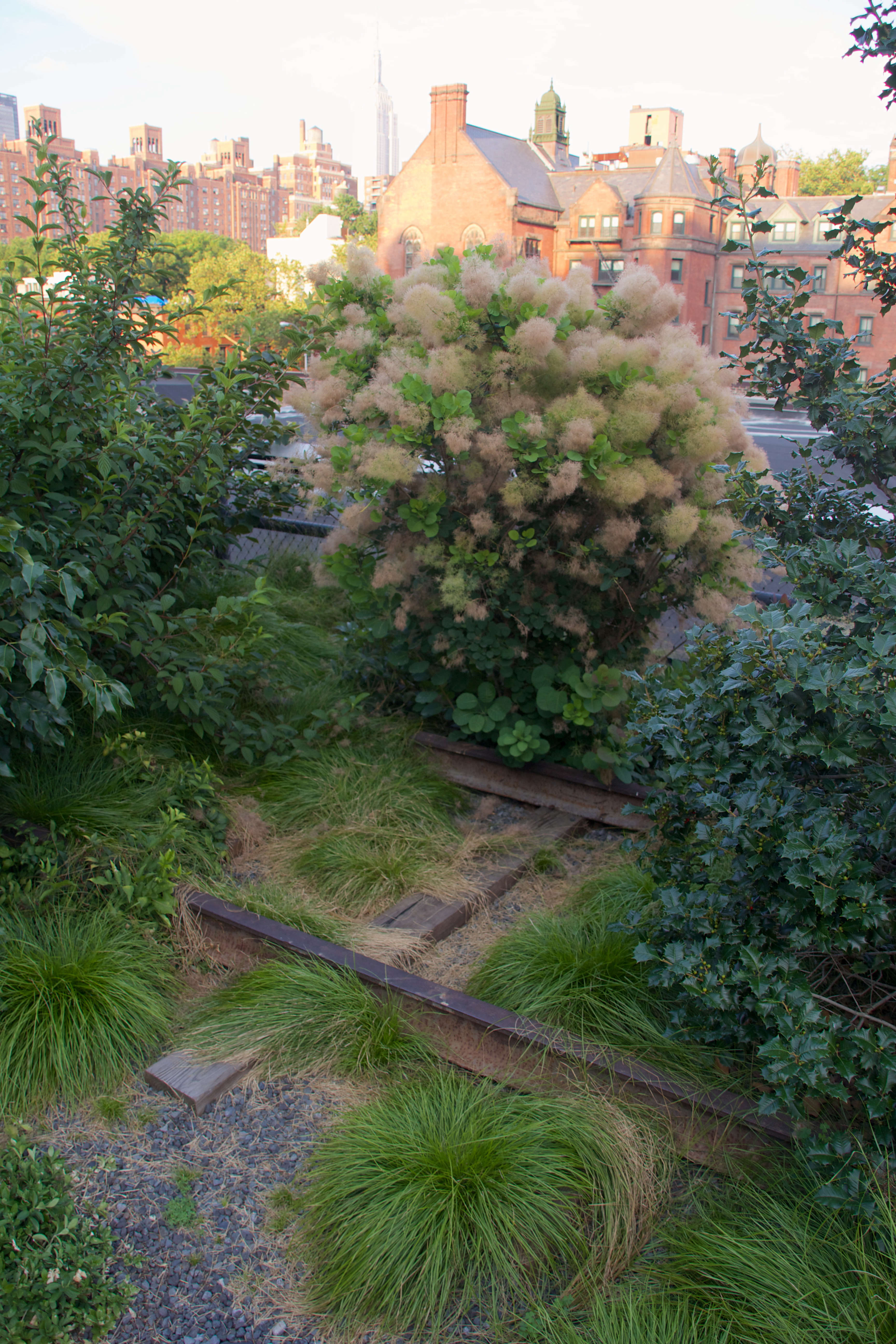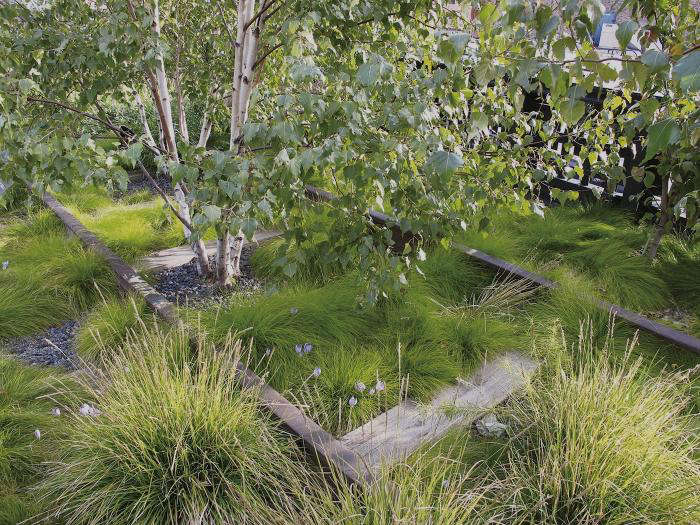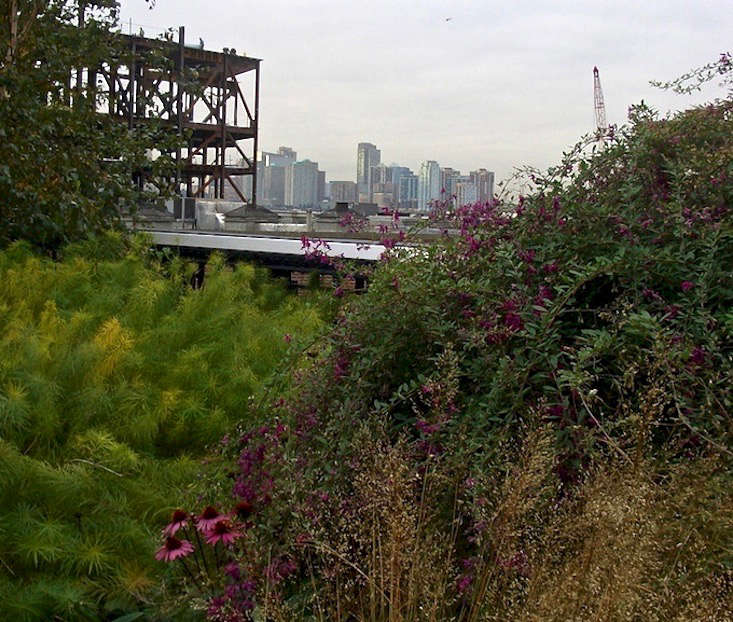A New York itinerary essential is an afternoon walking the High Line, a public park on Manhattan’s West Side built around a defunct elevated railway.
Under landscape architecture firm Field Operations, architects Diller Scofidio + Renfro, and Dutch planting designer Piet Oudolf created a dynamic and painterly park inspired by a larger aerial greenway, the 3-mile-long Promenade Plantée in Paris. Here’s what our frequent visits to the High Line have taught us for our own gardens:
Revitalize a Post-Industrial Landscape
Above: Grasses grow in and around the tracks of an abandoned railroad line on the High Line. Photograph by Mike Peel via Wikimedia.
From 1934 to 1980, the West Side Improvement Project of New York City brought an elevated train for industrial use running from 34th to Spring Streets. Twenty-four years later, the empty train tracks were revived by Friends of the High Line. Abandoned industrial areas are plentiful in urban environments, but there are notes to take for the residential gardener: replant an overgrown side yard, opt for raised beds in a backyard of toxic soil, or integrate hard-to-remove hardscape with new, feathery perennials.
Use Less Water
Above: Photograph by Mike Peel via Wikimedia.
The structure underlying the High Line is the greatest contributor to reducing stormwater runoff and keeping drainage healthy. Layers of topsoil, clay-based subsoil, filter fabric, and crushed gravel all create a clean, low-maintenance system. The takeaway? For shadier and wetter parts of the garden, consider a layer cake of drainage mats with fine and coarse gravel. The park also sees a complex drip irrigation with the option for automatic and manual watering that is turned off and on depending on the season.
Close the Loop: Erosion Control
Above: Photograph by Mike Peel via Wikimedia.
The High Line’s many perennials, grasses, and shrubs turn out plenty of waste material that is reused through Fresh Kills in Staten Island and an on-site compost system. Always working toward a closed-loop recycling system, the park recently implemented the use of homemade mulch from fallen leaves and clipped winter stalks; the mulch can be seen in areas of the park where erosion has taken hold. Reusing plant cuttings and discarded material is not only sustainable, but a smart financial investment for a garden of any size.
Design From Big to Small
Above: Photograph by Piet Oudolf. For more, see Required Reading: How to Recreate Piet Oudolf’s Painterly Landscapes.
When parsing out the entirety of a large landscape, Oudolf works from big to small. Designing a base of trees while considering a host of conditions for each variety and the right location for it in the garden. Next are the hardier shrubs, and sometimes flowering perennials followed by a peppering of grass layers for a delicate, organic effect.
Select Plants for Hardiness and Purpose
Above: Of the 100,000 plants across 300 species at the park, each botanical has a purpose and a story. Take Wild White Indigo (Baptisia alba), a deer-proof plant that acts as a natural fertilizer by increasing nitrogen levels in the soil. Or Blond Ambition (Bouteloua gracilis), a grass used in erosion control that tolerates shallow soil and air pollution (an adapted urban dweller). The majority of the plant species at the park are American natives, but all are selected for their hardworking attributes in equal measure to their beauty. For a list of all the species see the High Line Plant List.
Create a Pathless Landscape
Above: Photograph by Angelune des Lauriers via Wikimedia.
Architects Diller Scofidio + Renfro designed what they call a “pathless landscape” with pre-cast concrete pavers whose tapered ends organically diffuse into plant beds. The open joints between the pavers encourage growth, “like wild grass through cracks in the sidewalk.” Consider the architects’ approach when designing or shopping for hardscaping elements: Does the color of the stone compliment surrounding foliage? Is there a section of the garden where clumped plant life could be integrated into an structural element? These considerations help integrate architecture with agriculture for a softly blended landscape.
Consider Foliage in the Context of a Space
Above: Photograph by Marcin Wichary via Flickr..
When Field Operatures and Piet Oudolf set out to revive the High Line track, hardscaping and planting was directly inspired by the self-seeded, overgrown landscape that appeared on the defunct rail tracks in the 1980s. Some tracks were filled in with loose gravel while others, particularly points of railroad switch, where used as planters by Oudolf.
Paint with Texture and Variety
A modern Dutch painter, Oudolf is a master of color design but he also considers the texture of every wisp of grass, composite bloom, and structural branch. Pink Muhly Grass is a favorite seen at the High Line. It’s bright green in the summer and turns to pink or bronze in the fall with a cloud-like texture. Then there are terra-cotta Yarrow blooms in summer tones of dark orange and yellow with silvery foliage in the winter. A painter’s palette of 300 some materials allows for accidental color and pleasing patterns across a long landscape.
Plant According to Microclimates of the Garden
Above: In late spring, New York’s High Line Park is covered with deep pink Allium christophii and white Allium nigrum. As Mr. Oudolf explains, the bulbs “make very good plants for random scattering.” For more, see Required Reading: How to Recreate Piet Oudolf’s Painterly Landscapes. Photograph by Piet Oudolf.
The 1.5-mile garden that runs parallel to the Hudson River sees different levels of wind exposure, light conditions affected by neighboring buildings, and soil depths predetermined by the High Line’s train tracks. These factors are all major considerations in the planting of each section. For example, in an area with low soil depth and naturally poor drainage, gardeners planted a crop of Graceful Cattail (Typha laxmannii), for its ability to cope with a plugged drainage system. It’s rare that the home gardener is working on the same scale to a public park, but even the smallest garden has different microclimates to consider for successful planting and plant relationships.
Accept the Beauty of Decay: The Four-Season Garden
Above: Photograph by Frank Schulenberg via Wikimedia.
At the core of Oudolf’s design approach is seasonal planting and a primarily uninterrupted process of decomposition. As the designer told The New York Times in 2008, “You accept death. You don’t take the plants out, because they still look good. And brown is also a color.” Shifting the focus away from purely flowering varieties connects the gardener to the heart of the plant and the garden as an evolving ecosystem. “You want a moment in the garden to be quiet,” Oudolf reminds us.
For more garden inspiration see our posts:
- Required Reading: How to Recreate Piet Oudolf’s Painterly Landscapes.
- Secretes to Surviving a Hurricane: NYC’s High Line Park.
- 10 Perennial Gardens Inspired by Piet Oudolf.


















Have a Question or Comment About This Post?
Join the conversation